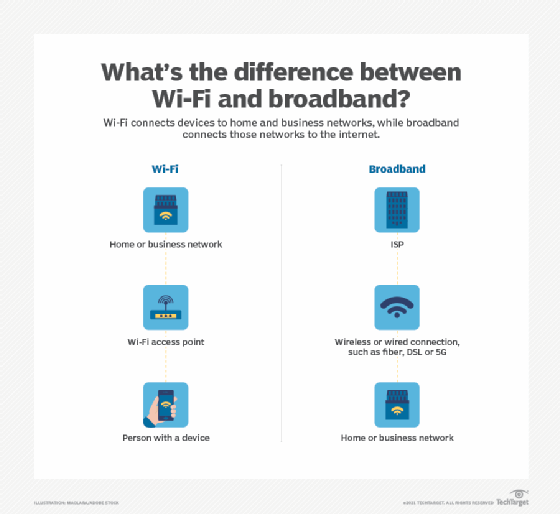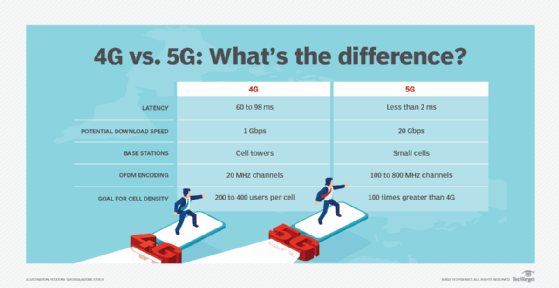wireless broadband (WiBB)
Wireless broadband (WiBB) is high-speed internet and data service delivered through a wireless local area network (WLAN) or wireless wide area network (WWAN). As with other wireless services, wireless broadband may be either fixed or mobile.
For the latter, high-speed internet is delivered wirelessly by an internet service provider (ISP) to the customer, and is commonly called wireless internet, broadband wireless or cellular internet. In this context, broadband is used as a shorthand way to refer to high-speed internet connectivity. For an internet connection to qualify as broadband in the United States, it must offer at least 25 Mbps download and 3 Mbps upload as defined by the FCC in 2015. The United Kingdom considers 10 Mbps download and 1 Mbps upload as broadband speed, and 25/30 Mbps is superfast broadband in both the UK and EU.
Wireless broadband is not the same as Wi-Fi, which is a way to connect computers and devices together into a LAN, and may be used to connect a network to the internet by another means. Wireless broadband implies that internet service itself is being delivered wirelessly to a single device, which may in turn be connected to other devices -- possibly using Wi-Fi or Ethernet.
Conceptually, think of wireless broadband as using your smartphone hotspot to provide internet service, but with dedicated equipment.
ISPs usually sell mobile broadband to consumers through a paid subscription to access the service. Generally, free municipal broadband/Wi-Fi would not be considered mobile broadband, even though it provides a similar service. With wireless broadband, a provider usually provides service over a wide area to many customers. A modem is used to connect to the provider's wireless network, with most modems linked to a single provider.
Wireless broadband is typically divided into either fixed or mobile categories, determined by if the connecting device is fixed in a single location or can be easily moved. A mobile connection would be in a cellphone, laptop or a dedicated mobile hotspot, and fixed wireless service would be a device designed to provide internet to an entire home or office.
Fixed wireless may be a standalone device with only an Ethernet jack to connect it to another network, or -- as with many modems today -- multi-use devices with a router and Wi-Fi access points built in. It may use an external antenna to provide better connectivity to the provider's base station, and it may be physically mounted to the building structure. Many of these antennas are directional, providing better reception if pointed at the service tower. Some services require (or have better performance with) a line of sight to the tower. Therefore, trained equipment installers may be required.

Cellular wireless broadband
Cellular wireless broadband is high-speed internet delivered by a cellular telephone network. The signals are sent and received by a cellular base station that wirelessly transmits to the consumer's modem, which is either embedded in a device, such as in a cellphone, or a separate device that is connected to other devices, such as to a home computer or network. Cellular wireless is the most popular form of mobile broadband.
Using a cellphone network for internet access has advantages and disadvantages. Modems are cheap and readily available and cell range is usually good, covering most geographic regions. Some rural areas may be too far away from towers, however, and not have high speed service. Many devices from many different people connected to a single tower can cause slowdowns, congestion and loss of service, and most service plans have relatively low data caps, which limit their usefulness or make them expensive to use for multiple devices. Furthermore, cellular wireless broadband plans without data caps will throttle performance down considerably once a certain usage threshold has been reached.
Modern 5G-NR technologies make using wireless broadband as a primary home internet connection more viable than in the past. Advances in cellular wireless technology and the underlying networks reduce many of the connectivity issues with traditional 4G LTE mobile broadband. 5G-NR offers extremely high speed in urban areas, rivaling dedicated fiber links without running cabling to every apartment. It also allows for lower wavelength signals than 4G, which can provide high speed over longer distances for better service in rural areas. The increased spectrum capacity also reduces issues with network congestion.

Other types of wireless broadband
WiMAX is a dedicated wireless broadband technology that's similar to Wi-Fi but uses different equipment. Devices that connect to a WiMAX signal are known as subscriber stations.
WiMAX covers an area greater than Wi-Fi but less than a cellular data connection. Conversely, possible data speeds are higher than traditional 3G cellular data, but slower than Wi-Fi. It has seen adoption in Europe, Australia and other areas as a popular way to provide last-mile internet access to homes, but has not experienced widespread adoption in the United States.
In practice, 4G LTE has eclipsed WiMAX for consumers, and 5G-NR will be completely superseded by 4G LTE. WiMAX still sees some use in metropolitan area networks, industrial applications and for large area networks such as at airports, however.
Several other technologies can provide wireless broadband service, but do not have widespread adoption or have been phased out in favor of newer technologies. They operate in the microwave radio spectrum:
- Local Multipoint Distribution Service (LMDS)
- Multichannel Multipoint Distribution Service (MMDS)
- Point-to-Multipoint Communication (P2MP, PTMP or PMP)
- General Packet Radio Services (GPRS)
Satellite internet technically fall into wireless broadband category, but is generally not classified as such.





